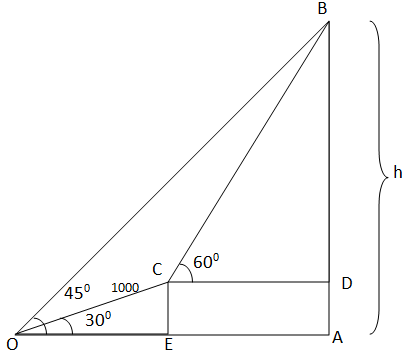
At the foot of the mountain the angle of elevation of the summit is found to be
Answer
531k+ views
Hint: In order to solve the problem, first of all draw a pictorial representation of the problem statement. Then use the concept of heights and distance along with trigonometric identities and the values for trigonometric terms at some particular angle in order to proceed.
Complete step-by-step answer:

In the given figure AB represents the mountain and h is the height of the mountain, O was the initial viewing point and after ascending 1km or 1000 m up the viewing point changes to C.
Let us now solve the problem geometrically rather than practically.
Let us now substitute the values known
Also we have for the same triangle
Let us now substitute the values known
Now let us consider triangle AOB
Let us now substitute the values known
Let us find sides of upper triangle
Now let us consider triangle BCD
Now, let us substitute all the values in above equation
Now let us solve the above equation for the value of h
Now, rationalizing the RHS in order to find the value of h
Hence, the height of the mountain is
So, option B is the correct option.
Note: In order to solve such questions related to the concept of heights and distances the figure plays the most important role so the problem must be started with the figure. Also the students must remember the values of trigonometric functions of some important angles as they are used several times.
Complete step-by-step answer:

In the given figure AB represents the mountain and h is the height of the mountain, O was the initial viewing point and after ascending 1km or 1000 m up the viewing point changes to C.
Let us now solve the problem geometrically rather than practically.
Let us now substitute the values known
Also we have for the same triangle
Let us now substitute the values known
Now let us consider triangle AOB
Let us now substitute the values known
Let us find sides of upper triangle
Now let us consider triangle BCD
Now, let us substitute all the values in above equation
Now let us solve the above equation for the value of h
Now, rationalizing the RHS in order to find the value of h
Hence, the height of the mountain is
So, option B is the correct option.
Note: In order to solve such questions related to the concept of heights and distances the figure plays the most important role so the problem must be started with the figure. Also the students must remember the values of trigonometric functions of some important angles as they are used several times.
Latest Vedantu courses for you
Grade 9 | CBSE | SCHOOL | English
Vedantu 9 CBSE Pro Course - (2025-26)
School Full course for CBSE students
₹37,300 per year
Recently Updated Pages
Master Class 11 Economics: Engaging Questions & Answers for Success

Master Class 11 Business Studies: Engaging Questions & Answers for Success

Master Class 11 Accountancy: Engaging Questions & Answers for Success

Questions & Answers - Ask your doubts

Master Class 11 Accountancy: Engaging Questions & Answers for Success

Master Class 11 Science: Engaging Questions & Answers for Success

Trending doubts
A boat goes 24 km upstream and 28 km downstream in class 10 maths CBSE

Why is there a time difference of about 5 hours between class 10 social science CBSE

The Equation xxx + 2 is Satisfied when x is Equal to Class 10 Maths

What is the full form of POSCO class 10 social science CBSE

Change the following sentences into negative and interrogative class 10 english CBSE

Discuss the main reasons for poverty in India




